


This book introduces the great civilization of Byzantium and shows the centrality of Byzantium’s role in world history. It also celebrates the founding by Robert Woods Bliss and Mildred Bliss of one of the major institutions devoted to the study of that civilization, the Byzantine Center at Dumbarton Oaks in Washington, D.C.
Through seven interrelated chapters, which were originally given as lectures at two meetings held in Washington in 1990 and 1991 to honor the fiftieth anniversary of Dumbarton Oaks, the contributors demonstrate the place of Byzantine civilization in world history—both Eastern and Western. At the same time, they show the place of Dumbarton Oaks in interpreting that civilization for what its founders called “an everchanging present.”
The first essay, written by Milton Anastos, a scholar who first came to Dumbarton Oaks in 1941, one year after the founding of the Byzantine Center, is devoted to the institution itself and to the role that it has played in Byzantine Studies over the past fifty years. The four following chapters, by Speros Vryonis, Dimitri Obolensky, Irfan Shahîd, and Angeliki Laiou, discuss the relationships between Byzantium and its neighboring civilizations, Islamic, Slavic, and Western European, and display the great legacy that Byzantium left to those cultures. The two final essays, by Gary Vikam and Henry Maguire, present Byzantine art, today the best known aspect of Byzantine achievement, and discuss its reception by modern critics and historians.





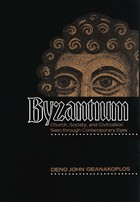
Byzantium is much more than a sourcebook. The running commentary reflects the most recent scholarly research in Byzantine studies and places each translated source in its precise historical context. Through the use of both primary sources and commentary, Geanakoplos has represented in all its richness and complexity one of the world's great civilizations. There is no comparable book on Byzantine history and civilization in any language.


In the middle of the fifteenth century, ominous portents like columns of fire and dense fog were seen above the skies of Constantinople as the Byzantine capital fell under siege by the Ottomans. Allegedly, similar signs appeared a few decades later and seven thousand miles away, forecasting the fall of the Mexica capital of Tenochtitlan—Tlatelolco to the Spanish and their indigenous allies. After both cities had fallen, some Greeks and Mexica turned to poetry and song to express their anguish at the birth of what has come to be called the “modern” era.
This study probes issues of collective memory and cultural trauma in three sorrowful poems, the “Lament for Constantinople,” the “Huexotzinca Piece,” and the “Tlaxcala Piece.” Composed by anonymous authors soon after the conquest of the two cities, these texts describe the fall of an empire as a fissure in the social fabric and an open wound on the body politic. They are the workings of creators who draw on tradition and historical particulars to articulate, in a familiar language, the trauma of the conquered.


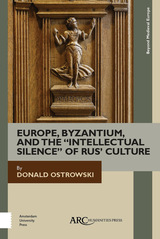

The ten holy women whose biographies are presented here represent a wide variety of Byzantine female saints: nuns who disguised themselves in male monastic garb; a repentant harlot who withdrew to the desert for forty-seven years of self-imposed isolation; a nun who escaped from Arab captivity to spend thirty-five years as a hermit on the abandoned island of Paros; a wonder-working abbess who slew a dragon; widows who found refuge in the ascetic life of the convent; married laywomen and a queen abused by their husbands.
The careers of these holy women demonstrate some of the divergent paths to sanctification in Byzantium, including mortification of the body, unquestioning obedience to a superior, repentance, acts of charity, prophecy, and miracle-working. At the same time, the texts of the Lives reveal the Byzantine ambivalence toward women, reflecting a paradox of civilization that simultaneously denigrated women as daughters of Eve and elevated Mary as the Mother of God and the instrument of man’s salvation.
These vitae, ranging from the fifth to the thirteenth centuries, also supplement traditional narrative histories by providing information on such aspects of Byzantine civilization as the impact of Arab and Bulgarian raids, iconoclasm, the monastic routine in convents, everyday family life and household management, and a smallpox epidemic in Thessalonike.
This collection of sacred biographies is the initial volume in a new Dumbarton Oaks series, Byzantine Saints’ Lives in Translation. The vitae selected for the series are rendered into English for the first time and are fully annotated.
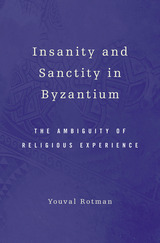
In the Roman and Byzantine Near East, the holy fool emerged in Christianity as a way of describing individuals whose apparent madness allowed them to achieve a higher level of spirituality. Insanity and Sanctity in Byzantium examines how the figure of the mad saint or mystic was used as a means of individual and collective transformation in the period between the birth of Christianity and the rise of Islam. It presents a novel interpretation in revealing the central role that psychology plays in social and historical development.
Early Christians looked to figures who embodied extremes of behavior—like the holy fool, the ascetic, the martyr—to redefine their social, cultural, and mental settings by reading new values in abnormal behavior. Comparing such forms of extreme behavior in early Christian, pagan, and Jewish societies, and drawing on theories of relational psychoanalysis, anthropology, and sociology of religion, Youval Rotman explains how the sanctification of figures of extreme behavior makes their abnormality socially and psychologically functional. The sanctification of abnormal mad behavior created a sphere of ambiguity in the ambit of religious experience for early Christians, which brought about a deep psychological shift, necessary for the transition from paganism to Christianity.
A developing society leaves porous the border between what is normal and abnormal, between sanity and insanity, in order to use this ambiguity as a means of change. Rotman emphasizes the role of religion in maintaining this ambiguity to effect a social and psychological transformation.

A gulf of centuries separates the Byzantine Empire from the academic field of Byzantine studies. This book offers a new approach to the history of Byzantine scholarship, focusing on the attraction that Byzantium held for Early Modern Europeans and challenging the stereotype that they dismissed the Byzantine Empire as an object of contempt.
The authors in this book focus on how and why the Byzantine past was used in Early Modern Europe: to diagnose cultural decline, to excavate the beliefs and practices of early Christians, to defend absolutism or denounce tyranny, and to write strategic ethnography against the Ottomans. By tracing Byzantium’s profound impact on everything from politics to painting, this book shows that the empire and its legacy remained relevant to generations of Western writers, artists, statesmen, and intellectuals as they grappled with the most pressing issues of their day.
Refuting reductive narratives of absence or progress, this book shows how “Byzantium” underwent multiple overlapping and often discordant reinventions before the institutionalization of “Byzantine studies” as an academic discipline. As this book suggests, it was precisely Byzantium’s ambiguity—as both Greek and Roman, ancient and medieval, familiar and foreign—that made it such a vibrant and vital part of the Early Modern European imagination.

How does sense perception contribute to human cognition? How did the Byzantines understand that contribution? Byzantine culture in all its domains showed deep appreciation for sensory awareness and sensory experience. The senses were reckoned as modes of knowledge—intersecting realms both human and divine, bodily and spiritual, physical and intellectual.
Scholars have attended to aspects of sight and sound in Byzantine culture, but have generally left smell, taste, and touch undervalued and understudied. Through collected essays that redress the imbalance, the contributors explore how the Byzantines viewed the senses; how they envisaged sensory interactions within their world; and how they described, narrated, and represented the senses at work. The result is a fresh charting of the Byzantine sensorium as a whole.

The essays in this volume investigate themes related to the place of law in Byzantine ideology and society. Although the Byzantines had a formal legal system, deriving from Justinian’s codification, this does not solve the problem but rather poses important questions. Was this a society which was meant to be governed by law? For answers, one must look at the intent of the legislators (to address specific problems, or to order society according to an ideal pattern?); the attitudes toward the law; the relationship between law, religion, literature, and art. What were the spheres—political, economic, private—that the laws and the lawgivers sought to regulate? The concepts of law and justice are quite different from each other, and the relationship between them is investigated here.
Of importance also, in this medieval society, are the connections between law and religion. There is the problem of the provenance of the law—whether the Emperor or God himself is the source of law—and the broad implications of the answer. At another level, ecclesiastical law was very important for everyday life, and the question arises of how much knowledge people had of it and how profound was their knowledge. Both people’s perceptions and their practices were shaped by their views of human justice and divine justice: whether these coincided, and whether they were administered through the same means, for the intervention of saints or icons might be seen as an alternative to human justice. As for human justice, there are questions that involve both society’s view of it and the education, knowledge, and interests of those who administered it.
Such issues are present in all medieval societies; the case of Byzantium is of particular interest because of the interplay between formal law and the conceptualizations and practices—some quite divergent from the ostensible purpose of legislation—which affected the legislators, the practitioners, and all of society.

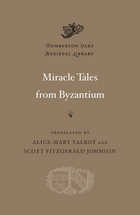
Miracles occupied a unique place in medieval and Byzantine life and thought. This volume makes available three collections of miracle tales never before translated into English. Together, the collections offer an exceptional variety of miracles from the Byzantine era.
First are the fifth-century Miracles of Saint Thekla. Legendary female companion of the Apostle Paul, Thekla counted among the most revered martyrs of the early church. Her Miracles depict activities, at once extraordinary and ordinary, in a rural healing shrine at a time when Christianity was still supplanting traditional religion. A half millennium later comes another anonymous text, the tenth-century Miracles of the Spring of the Virgin Mary. This collection describes how the marvelous waters at this shrine outside Constantinople healed emperors, courtiers, and churchmen. Complementing the first two collections are the Miracles of Saint Gregory Palamas, fourteenth-century archbishop of Thessalonike. Written by the most gifted hagiographer of his era (Philotheos Kokkinos), this account tells of miraculous healings that Palamas performed, both while alive and once dead. It allows readers to witness the development of a saint’s cult in late Byzantium. Saints and their miracles were essential components of faith in medieval and Byzantine culture. These collections deepen our understanding of attitudes toward miracles. Simultaneously, they display a remarkable range of registers in which Greek could be written during the still little-known Byzantine period.

This companion to the two-volume Dumbarton Oaks Medieval Library edition and translation of the Histories by Laonikos Chalkokondyles is the first book-length investigation of an author who has been poorly studied. Providing biographical and intellectual context for Laonikos, Anthony Kaldellis shows how the author synthesized his classical models to fashion his own distinctive voice and persona as a historian.
Indebted to his teacher Plethon for his global outlook, Laonikos was one of the first historians to write with a pluralist’s sympathy for non-Greek ethnic groups, including Islamic ones. His was the first secular and neutral account of Islam written in Greek. Kaldellis deeply explores the ethnic dynamics that explicitly and implicitly undergird the Histories, which recount the rise of the Ottoman empire and the decline of the Byzantine empire, all in the context of expanding western power. Writing at once in antique and contemporary modes, Laonikos transformed “barbarian” oral traditions into a classicizing historiography that was both Greek and Ottoman in outlook.
Showing that he was instrumental in shifting the self-definition of his people from Roman to the Western category of “Greek,” Kaldellis provides a stimulating account of the momentous transformations of the mid-fifteenth century.

The New Testament lay at the center of Byzantine Christian thought and practice. But codices and rolls were neither the sole way—nor most important way—the Byzantines understood the New Testament. Lectionaries apportioned much of its contents over the course of the liturgical calendar; its narratives structured the experience of liturgical time and shaped the nature of Christian preaching, throughout Byzantine history. A successor to The Old Testament in Byzantium (2010), this book asks: What was the New Testament for Byzantine Christians? What of it was known, how, when, where, and by whom? How was this knowledge mediated through text, image, and rite? What was the place of these sacred texts in Byzantine arts, letters, and thought?
Authors draw upon the current state of textual scholarship and explore aspects of the New Testament, particularly as it was read, heard, imaged, and imagined in lectionaries, hymns, homilies, saints’ lives, and as it was illustrated in miniatures and monuments. Framing theological inquiry, ecclesiastical controversy, and political thought, the contributions here help develop our understanding of the New Testament and its varied reception over the long history of Byzantium.

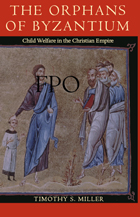

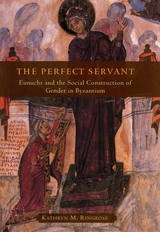
Accepted for generations as a legitimate and functional part of Byzantine civilization, eunuchs were prominent in both the imperial court and the church. They were distinctive in physical appearance, dress, and manner and were considered uniquely suited for important roles in Byzantine life. Transcending conventional notions of male and female, eunuchs lived outside of normal patterns of procreation and inheritance and were assigned a unique capacity for mediating across social and spiritual boundaries. This allowed them to perform tasks from which prominent men and women were constrained, making them, in essence, perfect servants.
Written with precision and meticulously researched, The Perfect Servant will immediately take its place as a major study on Byzantium and the history of gender.
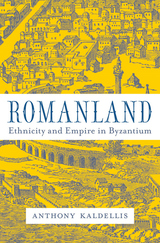
A leading historian argues that in the empire we know as Byzantium, the Greek-speaking population was actually Roman, and scholars have deliberately mislabeled their ethnicity for the past two centuries for political reasons.
Was there ever such a thing as Byzantium? Certainly no emperor ever called himself “Byzantine.” And while the identities of minorities in the eastern empire are clear—contemporaries speak of Slavs, Bulgarians, Armenians, Jews, and Muslims—that of the ruling majority remains obscured behind a name made up by later generations.
Historical evidence tells us unequivocally that Byzantium’s ethnic majority, no less than the ruler of Constantinople, would have identified as Roman. It was an identity so strong in the eastern empire that even the conquering Ottomans would eventually adopt it. But Western scholarship has a long tradition of denying the Romanness of Byzantium. In Romanland, Anthony Kaldellis investigates why and argues that it is time for the Romanness of these so-called Byzantines to be taken seriously.
In the Middle Ages, he explains, people of the eastern empire were labeled “Greeks,” and by the nineteenth century they were shorn of their distorted Greekness and became “Byzantine.” Only when we understand that the Greek-speaking population of Byzantium was actually Roman will we fully appreciate the nature of Roman ethnic identity. We will also better understand the processes of assimilation that led to the absorption of foreign and minority groups into the dominant ethnic group, the Romans who presided over the vast multiethnic empire of the east.
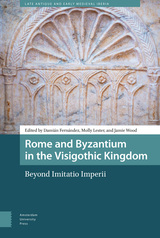


The church of San Marco of Venice has long played a central role in Venetian political, ceremonial, and religious life. Its renowned assemblage of mosaics, sculpture, metalwork, and reliquaries are, in origin, Roman, Byzantine, Venetian, or Venetian imitation of Byzantine designs. In San Marco, Byzantium, and the Myths of Venice, the authors assess the significance of the embellishment of the church and its immediate surroundings, especially during the thirteenth and fourteenth centuries, when most of the Byzantine material was acquired, largely from Constantinople. The church and its decoration are studied in relation to Venice’s interests abroad and on mainland Italy. The authors address the diverse styles, sources, meanings, and significance of this art, both individually and as an ensemble.
Building upon developments in scholarship since Otto Demus’s masterly studies of the church, the book offers new insights into the inspiration, purposes, and mutability of San Marco and the myths that inspired and motivated Venetians.


READERS
Browse our collection.
PUBLISHERS
See BiblioVault's publisher services.
STUDENT SERVICES
Files for college accessibility offices.
UChicago Accessibility Resources
home | accessibility | search | about | contact us
BiblioVault ® 2001 - 2024
The University of Chicago Press









